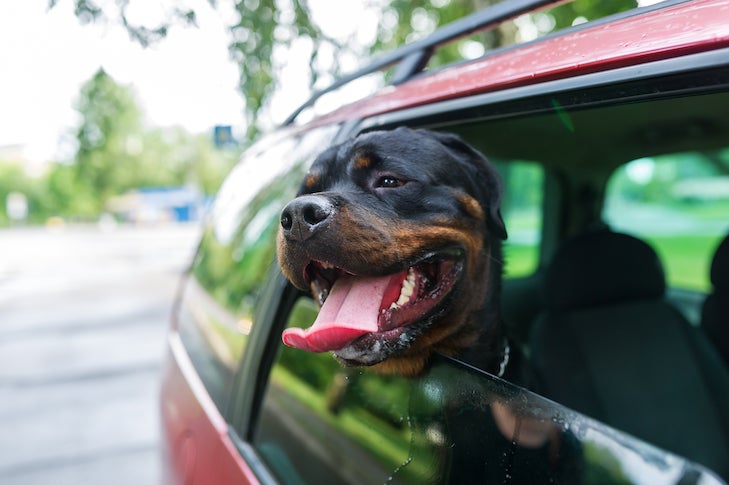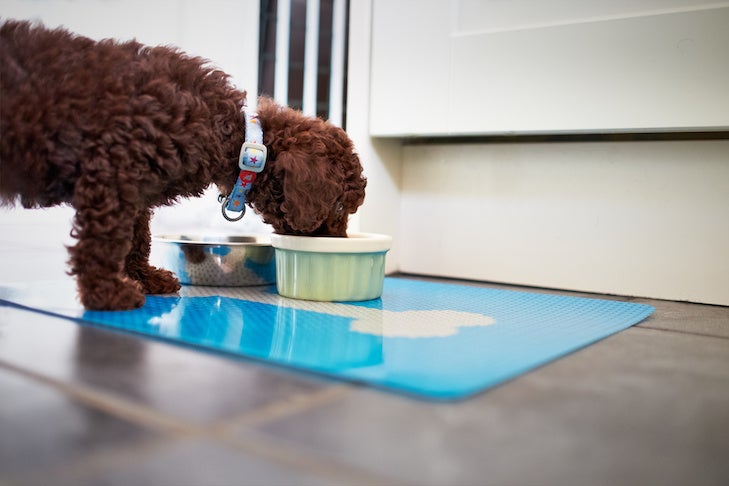
AKC is a participant in affiliate advertising programs designed to provide a means for sites to earn advertising fees by advertising and linking to akc.org. If you purchase a product through this article, we may receive a portion of the sale.
You’re walking through a parking lot and you hear a dog barking frantically. A couple of rows over, a dog is pacing and pawing inside a car. It’s a hot day, and your instincts as a responsible dog owner kick in. You rush over while searching for something to break a window.
Before you pick up a rock, stop and think. By breaking that window, you may be breaking a law. Even worse, your well-meaning action may do more harm than good.
It’s just not as simple as putting on your superhero cape and freeing a pup in peril. Good Samaritan laws vary across jurisdictions. Acting without understanding the law could leave you liable for property damages and the safety of the dog and the community.
Over a dozen states have recently enacted Good Samaritan laws limiting liability for individuals who remove a dog from a car, but details vary widely, according to Michigan State University’s Animal Legal and Historical Center.
Indiana, for example, makes rescuers liable for half the damage to the car. Delaware requires rescuers to leave a note. In Arizona and California, you are required to stay with the dog until authorities arrive. Some allow only first responders to remove an animal. Other state laws provide little guidance, so breaking into a car—especially if the animal wasn’t in danger—could leave you subject to vandalism, theft, or other criminal charges.
Loopholes for Thieves
The AKC Government Relations (AKC GR) team works with state legislatures to be sure new laws are balanced and sensible. We want to protect pets, but limiting all legal liability for breaking into a car to rescue an animal can have unintended consequences. Complete immunity from prosecution might give a green light to dog kidnappers and vandals.
Consider the person who safely secures a dog in a vehicle after dark in the training club parking lot to set up an AKC Rally practice course inside. That person could return to find the car’s windows smashed and the dog gone, even if the dog was in no danger. The same goes for the owner of a motorhome parked outside a dog show with the air-conditioning on full blast.

In several states and communities, AKC GR has helped amend proposals that would have removed all liability for individuals who break into a vehicle and release a dog. Instead, AKC GR supports laws that require that specific safety and notification steps be taken, such as calling 911, securing the dog and vehicle, and leaving a note if the dog is taken elsewhere.
With dog theft on the rise, unless appropriate controls are in place, well-intended laws can create big loopholes for thieves. The person breaking a window and taking a dog may not be headed straight to the animal shelter, and an accomplice may be waiting until the area is clear to steal other property from the vehicle.
There’s also the issue of unintended consequences that may not be covered by Good Samaritan liability provisions. For example, what if the released dog bites somebody? Is the person who released the dog liable for damages? What if the dog escapes, runs into traffic, and is hit by a car or causes a wreck?
Taking a Step Back
So, what can you do? While nothing in this article should be construed as legal advice, there are some commonsense actions that you should consider before attempting a rescue.
First of all, as a dog owner, never leave a dog in a vehicle where their health and safety could be compromised. It’s also wise to avoid the appearance of doing this, even if you believe the situation is safe.
If you see a dog in a troubling situation, consider the following:
- Does the dog show physical signs of being in immediate danger?
- Is the air-conditioning on or is the vehicle otherwise ventilated?
- Is the dog in the shade, in a spot where that is not experiencing significant heat gain?
- Is the driver present, perhaps standing nearby (maybe having gotten accidentally locked out, with a locksmith on the way)?
- Is there a law enforcement official on the scene or did another concerned person already call for help?
After a quick assessment, if you still have a reasonable belief that the dog is in immediate danger and no one else has taken action, think about how you can safely and lawfully proceed. Good Samaritan laws in many jurisdictions require you to call law enforcement and follow instructions. If you don’t know whom to call, dial 911.
If instructed by law enforcement to enter the car, consider how you will safely secure the dog. Do you have a leash, belt, or purse strap? Do you have water for the dog? What will you do if a panicked or defensive dog comes out struggling or biting?

Check first for an open door. If you must break a window, choose one that will cause the least risk of harm to yourself, the dog, and the vehicle.
After you free the dog, be responsible for their safety until authorities arrive. If you remove the dog from the immediate area to take them to a vet or animal control, contact authorities and leave a note on the vehicle with your name, contact information, and specifically where you are taking the dog. You may also be responsible for securing the vehicle and its contents.
 This article originally appeared in the award-winning AKC Family Dog magazine. Subscribe today!
This article originally appeared in the award-winning AKC Family Dog magazine. Subscribe today!
This article is intended solely as general guidance, and does not constitute health or other professional advice. Individual situations and applicable laws vary by jurisdiction, and you are encouraged to obtain appropriate advice from qualified professionals in the applicable jurisdictions. We make no representations or warranties concerning any course of action taken by any person following or otherwise using the information offered or provided in this article, including any such information associated with and provided in connection with third-party products, and we will not be liable for any direct, indirect, consequential, special, exemplary or other damages that may result, including but not limited to economic loss, injury, illness or death.


